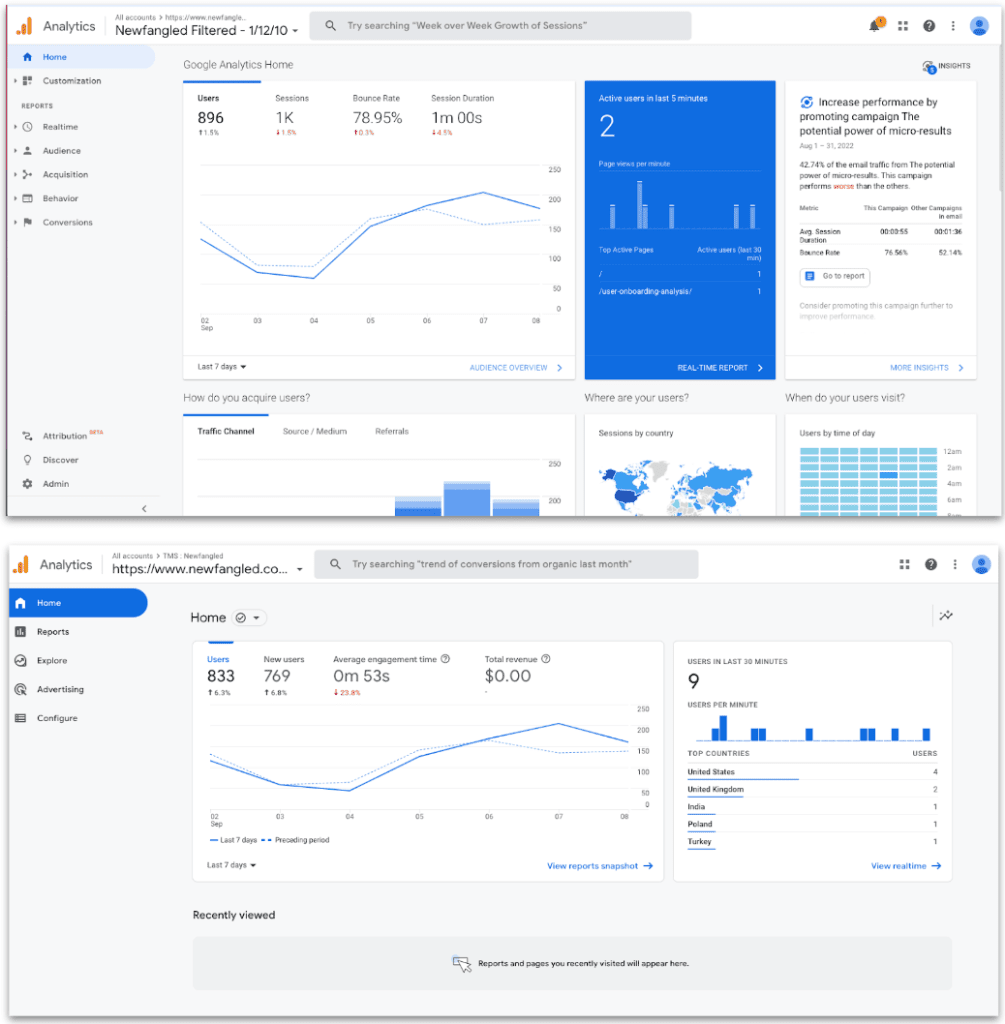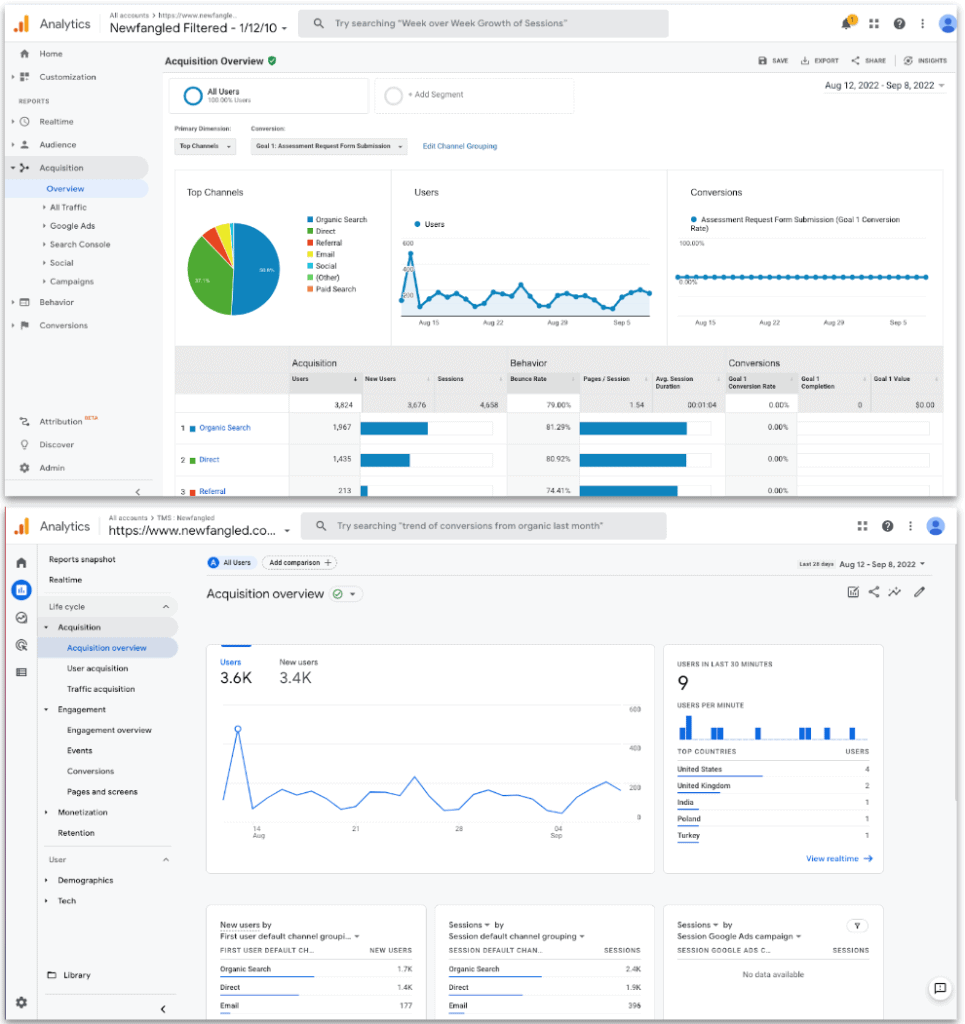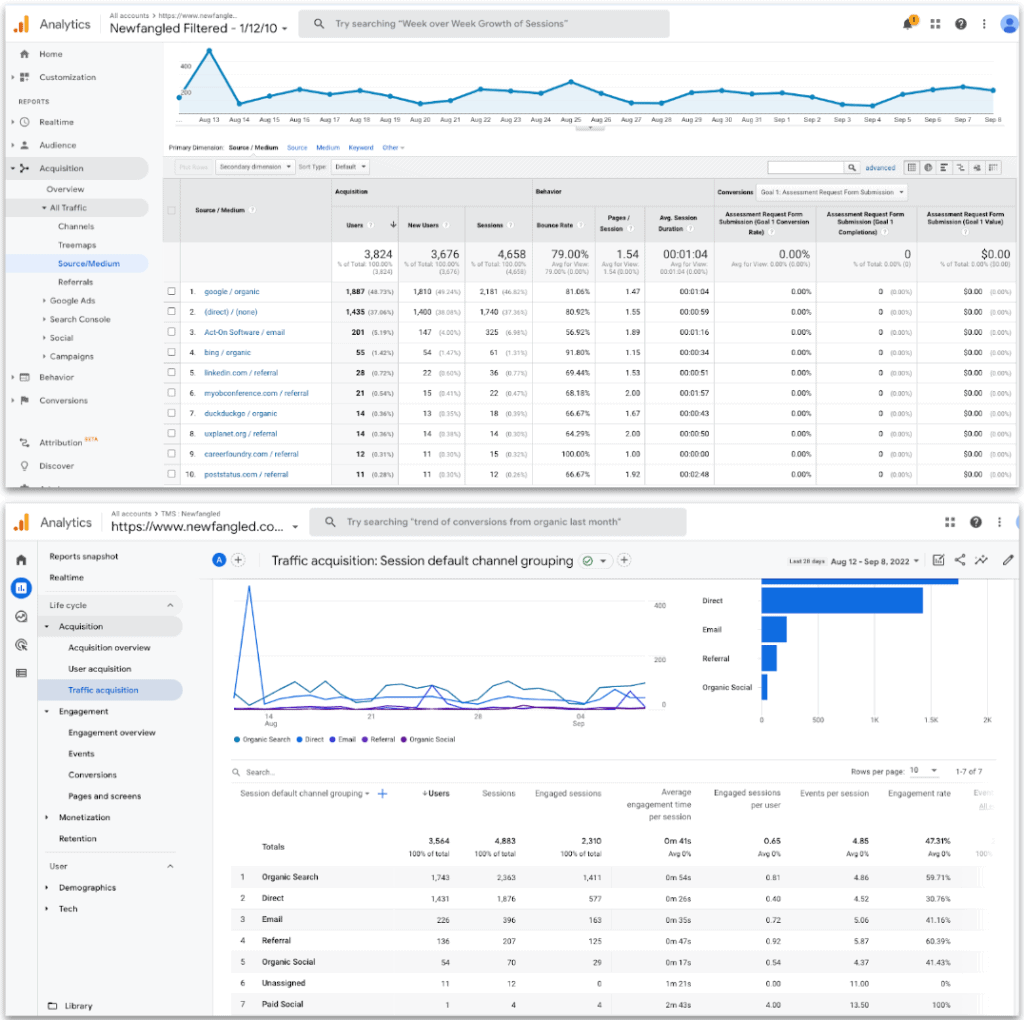Google Analytics 4 (GA4) is here. Released in October 2020, it’s designed to be the “future of measurement” for websites and mobile apps.
So what does this mean for companies like yours that are currently using Google’s Universal Analytics (UA) property for your web analytics? I’m glad you asked!
GA4 will completely replace UA effective July 1, 2023. After that time, UA (Google’s standard analytics property since 2013) will no longer track data. Instead, all data will flow through GA4.
That means there’s work you need to do now. In fact, I’ve mapped out four steps you should take to prepare. But first, let’s do a quick rundown of the bigger changes you’ll see in GA4.
What’s Different About GA4?
GA4 is not intended to be the next iteration of UA. In fact, it’s an entirely new platform.
That means you’ll see several differences when you first access GA4 — especially if you work a lot in UA today. And the new property introduces a modified interface (including a new data model and new metrics), a highly customizable reporting structure, and an increased level of insights.
Universal Analytics vs. GA4 Homepage layout:

Universal Analytics vs. GA4 Acquisition Overview layout:

Universal Analytics vs. GA4 Traffic Acquisition layout:

New Data Model and New Metrics in an Updated Analytics Interface
The overall navigation and tabs available in GA4 are different from what is available in UA. That’s because the GA4 data model is a significant change from the UA data model. Instead of processing data based on sessions and pageviews, GA4 data collection is based on events. Each event represents a unique user interaction with your website or app — when they scroll down a page, click on a link, or watch a video, for example.
The event-based data model also introduces three new metrics to track user engagement: engaged session, average engagement time per session, and engagement rate. These replace the UA metrics of average session duration, pages/session, and bounce rate.
The addition of these new metrics in GA4 and the elimination of metrics from UA means that reporting will also be different.
Fewer Pre-built Reports, but More Flexibility for Custom Reports
Most of the pre-built reports you’re used to seeing in UA (including the Behavior Flow report, my go-to for better understanding the user journeys on your website) are no longer automatically part of the new GA4 interface. Instead, users have the ability to create custom reports or export data for further analysis.
This reporting flexibility means businesses like yours can build reports with the data points that matter most to you. And unlike the dashboards in UA, your GA4 dashboards will provide more data. UA only pulls a portion of your website data, so what you’re reviewing now is actually sampled data. But with GA4, all of your website traffic flows in. That means more actual data can be used in reports. And that availability of unlimited data will provide more helpful insights that can be leveraged in your marketing initiatives.
More User Journey Insights and Predictive Analytics
Additional insights in GA4 give you the ability to gain a better sense of a user’s full experience — from their first visit to conversion. And since data is event-based, you’ll be able to see how users engage with your content across channels (web and app).
GA4 leverages machine learning and artificial intelligence to provide predictive insights. Using the dataset collected from your website or app, GA4 will equip you with enough information to predict some of the future behaviors of your users. For example, based on previous events, GA4 can predict the likelihood of a return visit from a user who was recently active on your site (their “churn probability” metric).
GA4 can also create predictive audiences based on these predictive metrics. So as you learn more about user behavior you can create custom audiences (most likely to x, least likely to y, etc.). These audiences can then be used with Google Ads or in other ways for specific targeting.
While it’s a number of significant changes, they’re all designed to enable marketers to make better decisions. That’s why it’s crucial to start preparing for the change today.
What to Do Today to Prepare for the GA4 Transition
Even though you can continue to use and collect new data in your UA instance through July 2023, there are a few things that you should do now so that you are ready for the day when UA is no longer an analytics option.
1. Set up your GA4 instance to establish historical data.
Keep running your UA instance, but start running GA4 concurrently as soon as possible.
The new property starts tracking data the day you set it up, but there’s no way to port any earlier data from UA. So setting up GA4 now means you’ll have data flowing in as soon as possible. This is particularly important if you want to compare results month over month or quarter over quarter.
Be sure to link your Google Search Console account to GA4 so that you can analyze your organic search data. You’ll also want to link your GA4 property to your Google Ads account to start sharing data and audiences. (Quick note: If you have multiple Google Ads accounts, GA4 will automatically share audiences with all accounts. This is different from UA where you could choose which ad account to share your audiences with.)
And while your first focus is on creating historical data in GA4, you don’t want to neglect the information in your UA instance. After July 1, 2023, you’ll be able to access your previously processed data in your UA property for at least six months. After that time, though, it’s unlikely you’ll have access to those reports. Your data is important, so I strongly encourage you to export your historical UA reports now, too.
2. Validate reporting and create your custom reports.
Running both properties together means you can compare the GA4 data and reporting with your already established UA instance. Continue to use UA as your source of truth as you verify the integrity of your GA4 data and reports. (Another quick tip: Don’t forget to exclude your internal IP addresses during your GA4 setup to keep your data clean and accurate.)
Once your GA4 instance is set up and tracking data, start creating your custom reports. Remember, you may have to create custom reports in GA4 for some of the default reports you currently access in UA.
Taking the time to review the data and reports now means you can be confident in your dashboards come July when GA4 will be your only source for web and app analytics.
3. Verify that event tracking is set up — and firing correctly.
Since events are at the core of how GA4 pulls data, you’ll want to pay close attention to your event tracking configuration. The goal is for everything you are currently tracking in UA to also be tracked in GA4. Google sets up some event information by default. You can also modify or create custom events.
Dual tagging will build a historical record for events (essentially duplicating what’s in UA in GA4) and will pass data to both platforms. This does require some updates to your existing account, but Google does a great job outlining several different ways this can be done.
Your best approach depends on the other technologies or platforms you are using. As an example, for our clients using Gravity Forms, we recommend deploying goals through Google Tag Manager in order to send events to each property while keeping your data clean.
4. Earn your GA4 certification.
Google recently announced the availability of a GA4 certification for users. And it’s perfect timing! Now the hours you invest to familiarize yourself with GA4 will also prepare you for the certification exam.
Exam preparation resources and learning paths will help you better understand the platform. And the added knowledge from the certification will give you the ability to better understand your company’s data so that you can make better decisions for your marketing efforts.
The transition to GA4 may feel overwhelming now. But with a few proactive steps today you’ll be set up for success come summer 2023!
